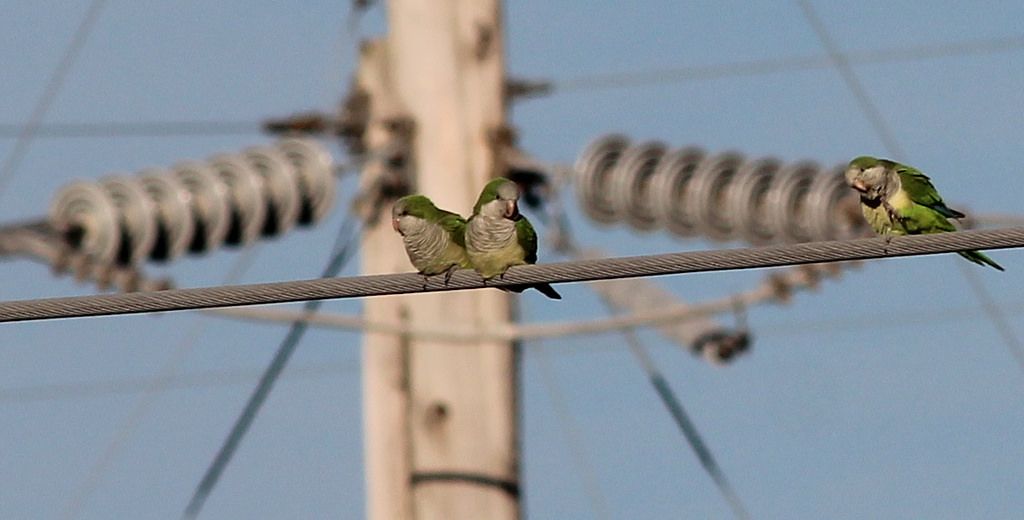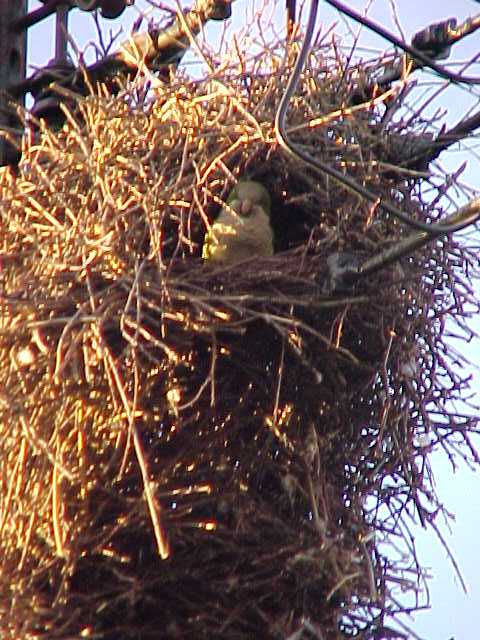BEWARE: Colorful Monk Parakeets Could Cause The Next Blackout On Your Block


Frequent power outages have frustrated southern Brooklyn residents during the last several years. And while blackouts and brownouts (a drop in voltage that causes lights to dim) are often attributed to a fallen tree or burnt cable, there is another seemingly innocuous threat to our electric grid: colorful Monk Parakeets.
The small, tropical green birds — native to Argentina — sometimes build their nests around electrical pole transformers, which can spark fires that knock out power in surrounding communities. A Con Edison spokesperson said a decade-old survey concluded the greatest concentration of Monk Parakeets in Brooklyn is located in Sheepshead Bay, Manhattan Beach, and Gravesend.

When the nests catch fire, they can cause widespread power outages. In 2007, 953 customers in Manhattan Beach lost power after a burning nest blew a transformer, according to Con Edison. A similar nest fire in 2009 knocked out power for 1,500 customers in Queens.
Con Edison was not able to immediately provide information about when the latest power outage caused by Monk Parakeets occurred in southern Brooklyn.
Monk Parakeets, also known as Quaker parrots, first appeared in New York City around five decades ago, the New York Times reports. They are thought to have arrived on broken shipping containers or escaped from homes where people were keeping them as pets. The parakeet’s natural environment in southern and central Argentina, which has snowy winters and humid summers, allowed the birds to adapt easily to New York’s climate, according to the Times.
Con Edison reports that previous studies indicate Monk Parakeet numbers have increased. The power company located 65 parakeet nests in Brooklyn and Queens in 2003. That number swelled to 500 by 2010. The Con Ed spokesperson said workers occasionally remove nests and debris that threatened their equipment.
City Councilman Chaim Deutsch said the Monk Parakeets came up during a recent meeting with Con Edison officials about the frequent power outages, brownouts, and flickering lights in southern Brooklyn.
“I’ve seen it myself. They form a nest on top of pole and it can start electrical fires,” said Deutsch.
The power outages — bird-related or otherwise — are hazardous for elderly and disabled residents who use life-sustaining equipment, Deutsch explained. The councilman proposed legislation last week that would require the Department for the Aging to distribute information to seniors about the importance of registering their home address and apartment number with Con Edison. The information would be distributed in multiple languages.
“Every time there’s a power outage, I ask [the Office of Emergency Management] and the NYPD if there’s anyone who relies on life-sustaining equipment. But they rely on Con Edison to give them that information,” Deutsch explained. “But sometimes there is a language barrier, where people may not understand they have to register.”
The Councilman added that power outages caused by strong wind gusts, downed trees, and corroding on pipes caused by Sandy’s floodwaters are also contributing to electrical outages in his district. He explained that Con Edison is currently working on upgrades to their equipment and he encouraged constituents to report any problems to the power company so workers can identify troubled areas.
Con Edison customers who use life-sustaining equipment can register by calling 1-800-752-6633. More information can be found here.